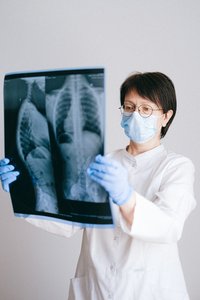- Education
-
Research
Current research
Talent
-
Collaboration
Businesses
Government agencies and institutions
Alumni
-
About AU
Organisation
Job at AU
News from the world of research can help lessen the fear and anxiety felt by many of the patients who are diagnosed with a tumour in the adrenal glands following a scan.
2021.01.22 |

A large population study shows, that only 3.3 per cent of 1,050 patients with randomly found adrenal tumours has cancer. Source: Epidemiology of adrenal tumours in Olmsted County, Minnesota, USA: a population-based cohort study. Ebbehoj, Andreas et al.The Lancet Diabetes & Endocrinology, Volume 8, Issue 11, 894 - 902
The prognosis for adrenal cancer is pretty horrifying. Only a little more than half of the patients are still alive three years after the disease is discovered.
However, a new study shows that although medical doctors relatively often discover a tumour in the adrenal gland of patients, the tumour is very rarely malignant.
"Until the mid-1990s, adrenal tumours were thought to be extremely rare. But the number of people who are diagnosed with an adrenal tumour is increasing every year. Unsurprisingly, this increase has taken place in parallel with the increasing use of CT and MRI scans," explains Medical Doctor Andreas Ladefoged Ebbehøj. He is a PhD student at the Department of Clinical Medicine at Aarhus University and the Department of Endocrinology and Internal Medicine at Aarhus University Hospital
In connection with his PhD studies, he travelled to a research group in the USA to take a closer look at adrenal tumours in a large population study. Andreas Ladefoged Ebbehøj and the rest of the research group at the Mayo Clinic in Minnesota discovered that around 1.5 per cent of all of those who are scanned in the abdominal region have an adrenal tumour. The tumour is often detected by accident.
In 2018, Danish hospitals carried out more than 160,000 CT scans of the abdominal region.
But although this results in more patients being told that an adrenal tumour has been discovered, the study shows that the message is not nearly as alarming as previously assumed.
"Previous studies said that up to twenty per cent of adrenal tumours were one of the life-threatening types, but this really didn’t fit with clinical experience," says Andreas Ladefoged Ebbehøj.
He and the rest of the team discovered that the most dangerous type of adrenal tumours – cancer of the adrenal gland – were nowhere near as frequent as previously described. In fact, only 3.3 per cent of the 1050 patients with randomly found adrenal tumours had cancer.
"Adrenal tumours are so frequent that all medical doctors will probably encounter patients with incidentally found adrenal thingies. I’ve read many journals in both Denmark and the USA, and I can see that doctors often tell patients that the tumour is probably cancerous. Our results show that this is completely wrong. It frightens a lot of patients unnecessarily," he adds.
"I certainly think that this new knowledge will change how we communicate with patients with incidentally found adrenal tumours."
Fortunately, the study also shows that it is possible to very precisely determine the risk of an adrenal tumour being malignant or not simply by examining the patient and the scan. It can be seen from the tumour’s size and shape, any bleeding and how much of the tumour is fat.
Even though the cancer diagnosis is excluded, an adrenal tumour may still be potentially life-threatening. This is the case if it produces hormones such as adrenaline or steroid hormones – substances which are normally well regulated in the body, but which, if there is over-production, may cause diabetes, life-threatening high blood pressure and other serious conditions.
Analyses by the researchers at the Mayo Clinic showed that 1.9 per cent of the patients with an adrenal tumour had the hormone-producing kind. But less than one in five patients with a randomly discovered adrenal tumour were actually tested for hormone overproduction as they ought to be according to the international guidelines.
"It's frightening that only 10-20 per cent were correctly examined, and I don’t see any reason why the figures should be much different in Denmark. The poor workup is probably due to this being a relatively rare condition. It is difficult to remember the guidelines so in an already busy day, it is easy to forgot referring the patient to the hormone examination," says Andreas Ladefoged Ebbehøj and summarises the most important finding:
"The tumour not being cancerous is great news, but doctors should still take blood samples to see whether it produces hormones. If doctors find one of the rare hormone-producing adrenal tumours, they can really save patient lives and quality of life."
The adrenal glands are two small but vital hormone-producing organs placed on top of each kidney which look a little like a triangular.
MD & PhD student Andreas Ladefoged Ebbehøj
Department of Clinical Medicine at Aarhus University and
Department of Endocrinology and Internal Medicine, Aarhus University Hospital
Email andebb@clin.au.dk
Mobil (+45) 2623 3463
Professor, Department Chair Jens Otto Lunde Jørgensen
Department of Clinical Medicine at Aarhus University and
Department of Endocrinology and Internal Medicine, Aarhus University Hospital
Email: joj@clin.au.dk
Mobil (+45) 2072 7383